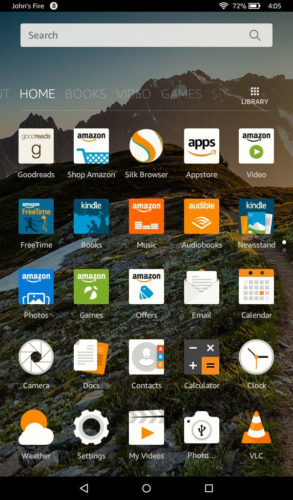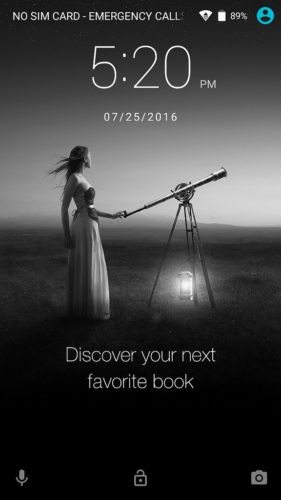 Late last week, a report claimed that Cyanogen Inc. was laying off 20% of its workforce and planned to “pivot” to “apps” to survive. Many CyanogenMod users and fans seemingly got confused with this report and thought that the future of CyanogenMod was in trouble.
Continue reading →
Late last week, a report claimed that Cyanogen Inc. was laying off 20% of its workforce and planned to “pivot” to “apps” to survive. Many CyanogenMod users and fans seemingly got confused with this report and thought that the future of CyanogenMod was in trouble.
Continue reading →
Rolandt
Shared posts
Cyanogen Clarifies Cyanogen Inc. Is Not Pivoting to Apps; CyanogenMod Remains Unaffected
 Late last week, a report claimed that Cyanogen Inc. was laying off 20% of its workforce and planned to “pivot” to “apps” to survive. Many CyanogenMod users and fans seemingly got confused with this report and thought that the future of CyanogenMod was in trouble.
Continue reading →
Late last week, a report claimed that Cyanogen Inc. was laying off 20% of its workforce and planned to “pivot” to “apps” to survive. Many CyanogenMod users and fans seemingly got confused with this report and thought that the future of CyanogenMod was in trouble.
Continue reading →
Weird Crowds, Weird Planet
Here’s the pre-read for the third and fourth sessions of Refactor Camp.
For our session tomorrow, Tuesday the 26th on The Weird State of the Crowd, we are running a bit behind, so have a partial pre-read for you in the form of this short summary document on Elias Canetti’s Crowds and Power. The session will be led by Renee DiResta and Megan Lubaszka. I’ll add the summary deck, which will also cover Eric Hoffer’s, The True Believer, to this post, once I have it. Apologies for the delay.
Update: the slides are in!
And for our final session on Thursday the 28th, which will attempt pull it all together via the capstone theme, Weird State of the Planet, here is the slide deck. This session will be led by Jordan Peacock and Sam Penrose.
Amazon Prime’s subsidized smartphones & tablets
Recently, Amazon Prime announced plans to offer a number of devices at a significant discount that came with ‘special offers’. These weren’t going to be bottom of the barrel hardware devices either. They launched the 7″ Fire Tablet (available in a number of colours) for just $50US last fall and a few weeks ago they unveiled the BLU R1 HD Android smartphone would be available for just $49US in the 8gb configuration ($10 more for the 16gb model with double the onboard ram as well).

July 12th was Prime Day – Amazon’s annual one day blow out sale. I picked up a number of items including the even further discounted 8gb Fire tablet in black for just $33US. I also ordered the 16gb BLU Android phone for just $59US. Both came with ‘special offers’ which are basically some preloaded software and lockscreen ads.
Note that I used Amazon.com (which I’m a Prime member of) rather than Amazon.ca because of the much wider offerings of .com and the fact I live 20 minutes from the border where I have a lot of Prime packages shipped to a mailbox I have in Lynden, Washington. As of this writing, neither of these devices is available in Canada or on Amazon.ca.
So what do you get for these deeply discounted prices? Quite a lot actually.
Let’s start with the Fire tablet
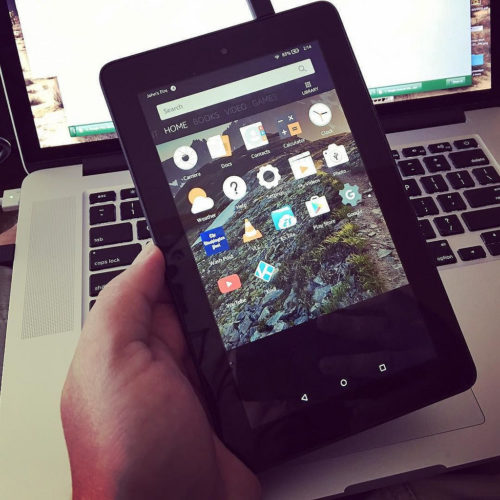
I wanted to get a newer Android tablet to replace my 2012 Nexus 7 tablet which I’ve pretty much stopped using because it’s just too sluggish and slow for just about anything I try to use it for. The Prime day price of $33 was just too good to refuse and I was also curious about the way they’d handle the ads.
Like most Amazon Kindle products, the Fire tablet came preconfigured with my Amazon account info so I literally just booted it up and it was ready to use straight out of the box. Also like other Fire products, it didn’t come with the Google Play store, but rather you use the Amazon Marketplace or the Prime exclusive “Amazon Underground” which is their own app store within an app store with a difference – all the apps and games are 100% free, including in-app purchases. Of course, it’s a lot more limited in selection than the full blown Play Store. You’re not blocked from side loading applications though. More on this in a bit.

The lock screen ad wasn’t as bad as I was expecting…at least for now. For the most part, I’ve mostly just seen Amazon-themed ads for their products or services. Some of them I might actually buy/download since it seems to be based on my shopping history since it’s all tied to my Amazon account.
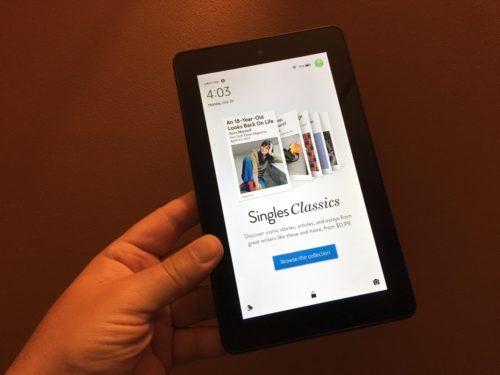
This might be a good/bad thing for other people but it doesn’t bother me at all since it’s simple enough to unlock the tablet and skip past the ad. But it’s definitely something to consider when buying a tablet like this for such a low cost since you’re giving Amazon your usage data in addition to viewing the lockscreen ads. I was able to opt out of data tracking but it wouldn’t let me launch some of the apps I had downloaded from the Underground store.

A simple google search revealed lots of websites explaining how to remove the ads and also side load the Google Play store. I followed the steps and was easily able to add the Play Store although the ad system wasn’t removed but I had read there was a 50% success rate in being able to do this depending on the version of the OS it shipped with. Amazon also seems to have gotten more aggressive with the updates to prevent these scripts from removing the ads although the Play Store remains intact. I’m fine with the ads and you can also pay $15 to remove them if they really bother you.
The tablet itself isn’t the thinnest or lightest on the market but compared to other low-end Android tablets at even double or triple the price it performs quite well with no noticeable slowdowns or general sluggishness I’ve seen on other devices. It’s still an incredible value for a fairly capable device that has a microSD card slot that can support up to 128gb of storage. Combined with adding the Play Store, I was easily able to add things like Kodi and VLC to make it a great media playing/streaming device.
BLU R1 HD
I’m fortunate to have access to a lot of different smartphones regularly but most are loaners from various manufacturers. I’ve wanted a dedicated Android phone for a while now and since I already own an iPhone 6s+ as my daily driver, it was too tempting to resist buying the BLU R1 HD at these prices.

I opted for the 16gb model with 2gb of ram. It’s a dual sim, unlocked phone that works on most carriers. Like the Fire tablet, it’s not the prettiest or thinnest device in it’s class, but it runs Android 6.0 Marshmellow very well. I actually find it to be very comfortable to carry, it’s pretty lightweight and feels solid rather than cheap. I added a 64gb microSD card to the onboard slot and it’s been able to run everything I’ve thrown at it.
BLU is a Miami based company making a bunch of great, low cost phones for a number of platforms. They all feature unlocked, dual sim card slots and varying specs depending on the price point.

This isn’t my first BLU phone. Last year for a project, I needed a Windows phone so I picked up their ‘Jr” 3G handset from the Microsoft store which still is a great little phone for the money ($80 last year) if for nothing else than it’s built in GPS software that works offline.

Also like the Fire tablet, it has a lockscreen ad and some preloaded apps. But it came stock with Android 6.0 and the Play store so that wasn’t an issue like the Fire tablet. There is a simple way to remove the lockscreen ads but upon rebooting, you have to reapply the ‘hack’.
By default, after applying the hack, you get a static lockscreen ad minus the ‘buy’ button and it can’t be changed. A workaround is to use a lockscreen app. But like the Fire, I can live with this…even when ads were fully enabled (and I suspect a future update will reinstate them on my phone), it wasn’t very intrusive and any other notifications would shrink the ad down.
Of course, you can just buy the phone for basically double the price to remove the ads if they bother you. The device is still a great deal at the full price but is that much sweeter at $49/59 with the ads.
The preloaded apps are the usual Amazon apps along with Goodreads, Audible and a few others. These can be removed from your homescreen but not uninstalled. Again, not a big deal as I use most of these already.
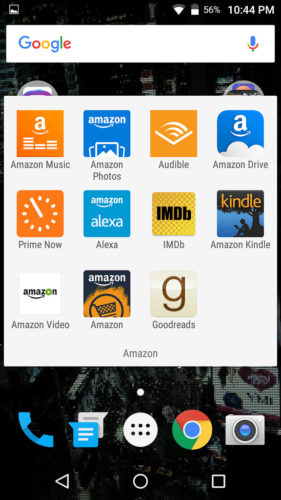
The R1 HD has a decent 8mp rear camera, front facing 5mp camera (with LED flash!), GPS and a great 5″ screen. It’s snappy and like the Fire tablet, has performed admirably with any and all apps I’ve thrown at it so far. It doesn’t have NFC which is a slight bummer but I can live with that. Someone commented on Facebook that this might be the ultimate burner phone and while it’s price makes it seem disposable, it’s anything but.
Despite the above somewhat glowing praise, it’s worth noting that neither of these devices feel as nice or as refined as devices from Apple or Samsung but that’s not the point.
At these prices, it’s worth having either of these devices to dabble in Android land if you’re an Apple user or if you need an inexpensive yet capable phone to replace a damaged or lost phone. The quality of these devices might even make you wonder why you’re paying so much more for those other devices.
I don’t have kids but the Fire tablet seems like it might be a great device for kids assuming you don’t have issues with the ads – you can create a switchable kid profile on the Fire tablet which may minimize the ad space as well as the shopping damage they could do if you want to save some money. You might even want to give them the BLU phone instead of your more expensive smartphone even just to watch Netflix, YouTube or just to play games without a sim card since you don’t have to activate it on a cellular network to use it.
Related Posts:
The post Amazon Prime’s subsidized smartphones & tablets appeared first on johnbiehler.com.
Ritual Views
A few years ago, I found my neighbor lying dead on the floor in her apartment. We lived across the hall from each other in crumbling basement units, the kind where the rising story arcs of young people on their way to something better intersect with the falling ones of older, sicker people on their way to something worse. For several years, she and I said hello as we crossed each other in the moulding staircase, she shepherding her trembling white dog. Then one night I heard someone screaming and ran out into the fluorescent buzz of the dank hallway. Her door was open, and a shaggy man in a jean jacket was crouched next to her body. She was epileptic; she had had a seizure and broken her neck. Her friend had called and called and there had been no answer. She had been lying there for some time.
After the ambulance took her away, I paced my apartment wondering what I could do or say to honor her life. I knew almost nothing about her. The superintendent, clutching the bannister in her dressing gown after the sirens woke her up, told me the woman was not as old as I had thought. She had a variety of health problems and couldn’t work. She left behind the fearful dog and an ailing cat. I’m a writer; it’s an article of faith for me that reality can be coaxed to dwell inside fresh language, that our new and singular lives demand contemporary forms of expression. Yet I found myself at a loss for words that could contain or acknowledge the transmundane nature of what had happened. Death seemed to need old words. I scrounged my cupboards and came up with a candle. Then I opened my computer and typed in the search term “prayers for the dead.”
I started with the one I knew the name of: Kaddish, the Jewish prayer of mourning. Yit’gadal v’yit’kadash sh’mei raba. B’alma di v’ra chirutei. Reading the Aramaic words on the screen, I didn’t feel I had the right to say them. Was it wrong to say Kaddish for someone who wasn’t Jewish? Was it wrong to say it if I wasn’t exactly Jewish? I tried looking instead for the Christian prayer, googling “ashes to ashes,” a phrase familiar from the movies. That felt even more foreign. I felt like a spy in a virtual sanctuary, and it seemed wrong to have entered sacred space so easily.
My candle was burning down. I googled “nonreligious poems for funerals” and found something noncommittal about a lark. I read it aloud, feeling like a cop-out.
About six months ago I started tentatively attending synagogue. I had a new boyfriend who was being too nice to me, and the small attentions — sending homemade word-puzzles in the mail, bringing me coffee in bed, holding my hand — felt like special treatment I didn’t deserve. Love made me feel guilty, and at the same time, it felt like contact with something greater and more mysterious than my individual narrative. Incongruously enough, the experience of being loved raised the same questions for me as attending at the death of my neighbor — what was human life for, and what did it mean? I wanted to find a place where people were talking about the tension between our unique lives and our participation in a greater cycle of life on Earth. I wanted to hear someone talk about how our time here should be spent.
My father grew up Jewish and my mother grew up Dutch Calvinist, so my sister and I grew up essentially neither. With my mother’s family, we celebrated what my sister calls “the capitalist holiday calendar.” We lived with my mother, and while we always had a Christmas tree and still hide chocolate eggs at Easter, she is a fervent secularist who saw that we never darkened the door of a church. When my father lived with a Jewish girlfriend, we participated in some Jewish ritual at their house, and occasionally went for Shabbat dinner or Passover at our grandparents’. Religious observance, however, mostly boiled down to the bar and bat mitzvahs of our endless cousins, three-day celebrations that started in the synagogue and ended on the dance floor in an uncles-gone-wild conflagration of Mardi Gras beads, smoke machines, and weed.
I felt like a spy in a virtual sanctuary, and it seemed wrong to have entered sacred space so easily
Christianity played no real part in how my mother thought about herself, or, by extension, about us. But for my father, Jewishness is an ethnic identity. As secularly inclined as my mother, he didn’t want my sister or me to become bat mitzvahs or receive a religious education. Yet when, as a teenager, I told my father I was going to dinner at a boyfriend’s house to meet his parents for the first time, he asked with concern, “Do they know you’re Jewish?” Things have changed in Canada since my parents’ and grandparents’ time: In my experience, the only people thinking about whether you’re Jewish are other Jews. Recently, someone described my last name as “an ethnic dog-whistle.” According to the Mishnah, however, if your mother is a horse you are a horse and if your mother is a donkey you don’t count. “This implies that ‘horse-hood’ is passed down through the mother, regardless of the father’s species,” say the experts at myjewishlearning.com.
Google “Judaism patrilineal descent” to call up the storm of “dissent over descent.” Myjewishlearning.com is in the first layer of results, flanked by other American sites run by Jewish organizations offering introductory essays on Jewish life and law. As you scroll down, sites like The Half-Jewish Network: Welcoming Adult Children and Grandchildren of Intermarriage start to crop up. A few years ago I was walking across a university campus and a girl in a pink baseball cap sporting a bejazzled J ran over to ask if I was Jewish; she seemed to be representing a campus club. When I explained that I was Jewish on the wrong side, she said, “Oh. Well it was nice to meet you anyway,” and dashed away from me. If you’ve never been told that your blood isn’t pure enough, let me say: it’s not a great feeling.
I chose a temple by scrutinizing photographs of rabbis online, looking into their faces for signs of rejection. The rabbi I found was young, female, and gay; it seemed probable that she had spent time thinking about boxes and who fits inside them and what happens to the people who don’t. I sent the rabbi’s bio to my sister; she’s always taken an interest in Jewish history, and the mysterious pain of existence has overshadowed significant periods of her life. She agreed to come with me to a Shabbat morning service to see what it was like. The Reform temple turned out to be up the street from the Orthodox one where my grandparents used to go; we pushed a red button outside the entrance and a uniformed guard let us in. “Shabbat shalom,” an old lady said to us as she passed in the hallway. “Shabbat shalom,” we responded, feeling like criminal imposters. It was the torpid height of August and services were being held not in the large hall (a sign by the door said, “Please turn off your cellphones. God knows how to reach you”) but in a small, red-carpeted chapel at the back of the synagogue. We slunk into a pew, our faces burning. Once the service started, we stood up and sat down when the others did, fumbling for the right pages. The congregation sang in Hebrew, and the cantillated progression of flattened notes was both vaguely familiar and utterly alien. Reading along in English, I caught glimpses of the sentiment that had brought me: “Author of language and light, help us to use words as You have, to cast light into dark waters, and draw out justice and truth.”
We went back a few weeks later for a Friday evening service that started with a vegetarian potluck, where we met more people in their twenties and thirties, some of whom were also Judaism newbies — Jewbies, as my sister and I started calling ourselves. A few were married to Jews or, like us, had Jewish fathers and were raised secularly. Everyone was madly in love with the queer, progressive rabbi. Over the next few months, in my sporadic attendance at Saturday morning services, I noticed other Jewbies becoming more proficient in the Hebrew prayers. I asked one how he had learned the complex formulations in the prayer-book — was he studying with one of the rabbis? “Oh, you can totally download the audio,” he told me. “I’ve been practicing in the car on my commute.”
The year before my father’s bar mitzvah, his family was living in Brazil, and he was sent home to Montreal to live with his grandparents and go to Hebrew school. At my great-uncle’s funeral a few years ago, a shaky old man came up to my father and placed a hand on his cheek — it was the rabbi who had taught him to read Torah. Historically, Jews learned to chant Torah from their fathers, a practice which gave way to special preparatory bar mitzvah classes where students learned to pronounce the Hebrew alphabet and intone the Torah cantillation style under the guidance of a rabbi. By the time my cousins were becoming bar and bat mitzvahs in the 1990s and 2000s, Hebrew school instruction might be accompanied by CDs — some learned their Torah portions only by ear and never learned to read Hebrew at all.
I’ve been learning to pray from YouTube. When I first searched for videos of Jewish prayers, I wondered if it were possible to culturally appropriate your own heritage by only partially participating in it. But, I reasoned, YouTube isn’t exactly a hidden drawer in a fusty oak desk — if people fluent in Jewish prayers were posting videos of how to sing them, didn’t that mean they wanted the uninitiated to learn? In the same way that YouTube is a semi-legal free-for-all, where uploaders blithely infringe copyright and only the most egregious offending videos are taken down, it fosters a kind of schoolyard education, where accurate and inaccurate information is circulated and debated. For someone with one foot in and one foot out of the formal space of the synagogue, YouTube felt reassuringly casual.
When I started looking for recordings that matched what I was hearing in temple, I expected the melodies to be standard. Instead, I found droves of singers who sounded nothing like our cantor. It seemed that nusachim, the traditional prayer melodies, developed regionally, incorporating elements of local musical culture as the Jewish diaspora migrated across the globe. A rabbi knows how to locate you within your family, your community, and the greater historical context of Jewish immigration to North America. YouTube knows my IP, but it doesn’t really understand where — in the landscape of Jewish diasporic traditions — I am. Some interpretations of the nusachim are now as different as the Frank Sinatra and Sid Vicious versions of “My Way.” Few video-makers announced which traditional form they were following, so I clicked on dozens, straining my ears for passages I recognized. I found videos of a rabbinic Sharon, Lois & Bram prancing to up-tempo prayers on guitar. I found stern videos of men with billowing beards in echoing sanctuaries. A YouTube series called Prayer-eoke featured Hebrew script that moved and spun as it was sung. Some of the videos came from cantors, and were associated with particular synagogues; some were of young men sitting on their beds, Middle Eastern cityscapes visible out their bedroom windows.
A sign by the door said, “Please turn off your cellphones. God knows how to reach you”
Learning in this hit-and-miss, impersonal way is the opposite of having a rabbi lay a hand on your cheek. But the variety offers an opportunity to find an aesthetic and personality for prayer that feels right. In the past, the version of Judaism available to you was limited to the practice of your own congregation; now that our lives extend into virtual space, it’s possible to compare Jewish life and prayer in Montreal and Mogadishu or Tel Aviv. I ended up watching mostly videos of women and girls; female cantors are new in the Jewish tradition, as is the participation of women in Torah reading. In my grandparents’ synagogue, men and women sat separately and my aunts did not become bat mitzvahs (one switched to a conservative congregation and became a bat mitzvah as an adult). I found it reassuring to watch a cantor named Marnie smiling in a sunny New Jersey synagogue office chanting the Reform version of Avot v’Imahot, a prayer referencing the ancestors: Elohei Avraham, Elohei Yitzchak v’Elohei Yaakov, Elohei Sarah, Elohei Rivkah, Elohei Rachel v’Elohei Leah. In the Orthodox version, the prayer mentions only the patriarchs of Genesis: God of Abraham, God of Isaac, and God of Jacob. This version blesses the matriarchs as well: God of Sarah, God of Rebecca, God of Rachel, and God of Leah.
There’s a video I keep coming back to. It opens in a backyard somewhere in pine-forested North America, where a pale girl of about 12 clutches a metal chalice in one hand and a blue prayer-book in the other. At the prompting of a parental voice offscreen, she grins shyly into the camera. “I’m Yael and I’m going to be singing Shabbat morning — Kiddush,” she says, stumbling over the word, “which begins with V’shamru.” V’shamru v’nei Yisrael et HaShabbat, laasot et HaShabbat l’dorotam b’rit olam. The people of Israel shall keep Shabbat, observing Shabbat throughout the ages as a covenant for all time.
The pine trees, the shabby white house with its air-conditioner teetering in a first-floor window, the oblivious joggers passing on the road — I’m reminded of the continuity of Jewish life and ritual through historical convulsions that have sent the Jews from the desert to the forests I know, from goatskin tents to aluminum siding, from closed study sessions for men and boys to YouTube clips of women and girls. It’s evidence of a living tradition, the capacity for ancient forms to shift and expand to fill with contemporary values, contemporary life. I loop back to the video’s beginning, drawing Yael and her backyard out of darkness, letting them fade into darkness again.
Of course, I could have emailed the rabbi and asked her how to find the right nusach versions. But I didn’t want to ask the rabbi; I wanted to skulk in the twilight glow of the internet watching preteens in their backyards so I could maintain a safe distance from real religious life. While the mind of the internet algorithmically sees me looking — all my banner ads are now for Jewish roots DNA tests — it doesn’t quite look back. I’d like to know these prayers, but I’m not sure what I plan to do with them. I can’t quite commit to saying them with conviction.
For people who grow up within a religious tradition, actual religious belief can seem comfortably optional. Belonging is established, and participation in religious rites can be an expression of cultural continuity rather than faith. But for someone brought up on the outskirts of a religious community, choosing to step inside seems to require a stronger declaration of belief. My sister and I are both squeamish about the idea of God; it’s just so starkly antithetical to the worldview we were raised with. For most of my life, “spiritual” was a dirty word — I still grimace involuntarily while typing it. “I kind of get it when I think about it as being basically nature,” my sister says. “I feel like I experience the divine when I look at pictures of baby animals on Instagram.” From what I’ve read, Jewish conceptions of God — like the melodies used in different synagogues — vary widely. The one I like best is the vision of a divine order that underlies the patterns of the natural world; a force that doesn’t necessarily deal in human affairs, but which we can glimpse in our dealings with nature and each other. The other idea I like is that the world is created anew every day, and that we are partners in its creation.
It feels like real life and virtual life are alternating steps on a staircase leading to a succession of rooms where belonging might be
Unlike Christianity, Judaism is not an evangelical religion, and it’s known for a preoccupation with in-group and out-group status. It’s possible to become a Jew through conversion, but there is a tradition that a rabbi should rebuff a potential convert three times. It’s considered a test of a convert’s sincerity, but it comes out of historical persecution; when Christianity became the state religion of the Roman Empire, Jews were forbidden to proselytize, and converting a Christian was illegal. Similar prohibitions persisted in Europe into the Middle Ages. In the U.S. Reform movement, secularly raised patrilineal Jews like my sister and I are now accepted after a course of study without a formal conversion, and if children with a Jewish father are raised as Jews they are fully accepted. In Canada, conversion — a lengthy process wherein a potential convert must be judged acceptable by a sponsoring rabbi before being questioned by a beit din, the regional rabbinic court, and finally immersed in a mikvah, the ritual bath — is still required.
Paradoxically, this may be why synagogues and rabbinical councils don’t seem squeamish about having tutorials on Jewish prayer online for anyone to access. Prayers don’t need to be kept under lock and key because, fundamentally, religious knowledge is not what makes you a Jew. In the eyes of most rabbis, if your mother is not a Jew, and you have not formally converted (a service as yet unavailable over YouTube) you are not a Jew, even if you know all the prayers by heart.
Since I’m not sure I will ever truly believe in God, I don’t think my goal is to convert. I may never become a real Jew. I may always feel ambivalent about participating in synagogue life and prayer. In the glow of my computer screen, repeating after Yael, I’m still not sure what right I have. But it feels like real life and virtual life are alternating steps on a staircase leading to a succession of rooms where belonging might be. The questions I started with, about love and death and the nature and purpose of human life, are grave enough to absorb all the traditions and inventions available to us. The virtual world isn’t free of these questions; we arrive bearing them.
Recently, I attended Saturday morning services after YouTubing my way to proficiency in two or three of the main prayers. In the six months or so since I had first googled “Montreal synagogues,” I had become more comfortable entering the temple, but I still felt self-conscious. This time, I was hungover and nervous. Coming with my new knowledge of prayer felt like showing up to tenth grade wearing a T-shirt for a cool band I didn’t know much about. (The most recent time I saw my father he was wearing a Wu-Tang Clan tee. “Do you even know what that is?” my sister asked. “No idea,” he said, “I just thought it was a nice T-shirt.”) When I arrived, I sat down with a few of the other Jewbies. We were in the big chapel, and it was full; it was the weekend before a wedding and the couple were there for their aufruf, a ceremonial calling-up to the Torah. Their families and friends packed the pews. When the rabbi started the service, she made a point of saying that even if it was your very first time in a synagogue, you should join in the singing anyway. The point, she said, was not to do everything perfectly, but to do it imperfectly together.
On a web page entitled “New to Jewish Prayer? Nine Tips for Beginners,” I had read a rabbi’s comment that prayer is a learned art, and the specific recitations of a Jewish service are meant to be objects for study. The post is on reformjudaism.org, a site run by an advisory board of Reform rabbis, cantors and educators, which makes a point of welcoming interfaith families to their resources. “If you become a regular you will learn them, but remember, no one is born knowing this stuff,” she wrote. I still felt like an imposter chanting the Hebrew phrases, but I noticed that much of the congregation sang hesitantly, muffing the repetitions and losing their places when pages turned. Behind me, I heard two old men matching the cantor note for note. Imagine, in this economy, I thought — old people knowing something. The series called Nisim B’chol Yom is my favorite — “For Daily Miracles.” Baruch atah, Adonai, Eloheinu melech haolam, matir asurim — Praise to you, Adonai our God, Sovereign of the universe, who frees the captive. Praise to you who has given the mind the ability to distinguish day from night. Who lifts up the fallen, who removes sleep from the eyes, slumber from the eyelids, who stretches the earth over the waters.
Much of ritualistic practice is about creating meaningful memories through repetition. It’s a way of grounding the profound eeriness of human life in the rhythms of nature and the passage of time. It feels a little sad that the memory I’ve created for myself of learning these rituals is of being alone in my dark apartment, watching the faces of strangers in their yards or bedrooms demonstrating how our ancestors spoke to the divine. I don’t as yet feel an ownership over the knowledge I’ve gained so strangely. But my deepest experience of connection to something transcendental was always solitary. I grew up in the country, surrounded by the kind of forest shown in the video of Yael’s house. I spent hours as a child and teenager wandering alone, pressing the springy moss on the rocks, wading in creeks and picking up fragile birch bark, always aware of the unseen presence — half mythical, half dangerously real — of bears. In a way, because Jewish prayer is a communal activity — traditionally, 10 Jews must be present for certain prayers to be said — I’ve found it tricky to square with my experiences of divine presence rooted in solitude. Learning prayers from YouTube allows me to approach the concept of prayer alone before entering the complicated social space of the synagogue.
Midway through the service, a wicker basket full of gummy candies was passed around the pews. The Jewbie next to me and I shrugged at each other; it wasn’t clear what they were for. Near the end of the service, the bride-and-groom-to-be stood on the bimah, having finished their Torah reading and discussion. At a signal from the rabbi, everyone around me rose and pelted the couple with candy. “For a sweet life,” I heard an old lady pronounce. I’m not sure the prayers and rituals that mark Jewish life belong to me, or whether I will come to believe that they do. But, like my dad and his Wu-Tang T-shirt, I just like them. I can’t go back and give myself a different upbringing that offers room for greater speculation about the stuff of life. But I can choose to start now to learn a language and set of rituals for this questioning that can, in time, acquire the patina of tradition.
Yahoo – Fire sale
Long-term investors pay heavily in lost opportunity.
- Only in the context of Yahoo’s awful execution over the last 4 years can the sale of its operating business be called a good deal for investors.
- Yahoo has agreed to sell its operating businesses excluding cash, patents and investments to Verizon for $4.83bn in cash which is expected to close in Q1 17.
- This is higher than I had been anticipating ($3bn) and in that context (see here), I can raise my valuation of Yahoo from $43.3 per share to $45.2.
- This is also assuming that my bearish view on Alibaba (see here) is correct.
- If I use the current share price of Alibaba, then my current valuation of Yahoo is $54.6 some 43% above the current share price of $38.3.
- Hence for those that are considering buying Yahoo’s shares now for a quick profit, things are looking good but I think that long-term Yahoo investors are faring very badly.
- This is because for the last 4 years Yahoo has had a huge opportunity to migrate the substantial traction that it has in fixed internet into mobile.
- However, through poor execution, I think this opportunity has been completely squandered.
- Even without games, Yahoo still has 41% coverage of the Digital Life pie and it claims to have 600m monthly active users.
- If I take these figures and apply them to RFM’s monetisation model, I estimate that if Yahoo had executed as well as Google, Facebook or Twitter, it should have generated $2.1bn in revenues from mobile devices alone in Q2 16A.
- In reality, Yahoo generated revenue of $259m from mobile, just 12% of its potential, highlighting just how badly Yahoo has failed to address mobile correctly.
- If this potential had been fulfilled, then I think that Yahoo’s core assets could easily have been valued in excess of 10x the price that Verizon is paying for them.
- This is why I think that long-term Yahoo shareholders have paid dearly for the missteps of the current management team and why this fire sale can be of little consolation.
- I doubt that Verizon will able to do much better with these assets and in that context Google and Facebook can focus on competing against each other in mobile and not worry too much about Yahoo.
- I still think that Yahoo shares will end up trading meaningfully higher than where they are today based on the sum of its parts and so it is worthy of consideration from that perspective.
- Elsewhere, Baidu, Microsoft and Samsung remain my top short term picks but I am keeping a very close eye on Tencent and Facebook where I am looking for the right time to enter.
- I remain negative on Alibaba, Google and Twitter.
Why Your Phone Dies When It Claims to Have Battery Left
The battery meter in the corner of a phone’s screen might make you think that you’re seeing a perfect, standardized measurement, but the reality is sometimes a little closer to the guess-your-weight booth at the carnival. Indeed, there’s a good chance your phone died despite proudly proclaiming that its battery has, say, 23 percent charge left, or your tablet hung on at 2 percent for what seems like hours. We’ve talked at length about how to squeeze more power from your smartphone battery and which chargers are best when your device is about to power down. But we don’t often discuss exactly why it’s so hard to predict batteries’ run time and state of charge to begin with.
Want a sneak peek of what we’re working on?
Sign up for our weekly newsletter for everything we’re working on and then some.
One way to understand some of the electrical concepts happening inside your phone is to use the analogy of an opaque water barrel, where the water it contains represents the power a battery can hold. (Visualizing water flows is a lot easier than trying to imagine invisible electrons.) Because you can’t see inside the barrel and, for our purposes, you can’t measure its contents on a scale, you need an indirect way to figure out how full the barrel is. If you open the spigot at the bottom of the barrel and water shoots out with force, you know the barrel is pretty full. Likewise, a steady but less forceful stream might tell you that the barrel is filled to somewhere in the middle, and a trickle would tell you it’s almost empty.

Think of voltage in an electrical system as similar to water pressure in a plumbing system. And just like the flow from a water container loses pressure as it empties, battery voltage sags as energy is discharged.
Voltage in an electrical system is like water pressure in a plumbing system. In your home, water pressure is constant and the supply is effectively unlimited; similarly, an outlet’s voltage is constant and the supply of electricity is effectively unlimited. But with a barrel, the amount of water is limited, and the water pressure diminishes as the barrel empties. Similarly, the amount of power in a battery is limited, and voltage goes down as the power in the battery is used. The key to measuring a barrel’s content is to know how much pressure corresponds to a certain amount of water, so that you can use one to predict the other. Similarly, if a car battery’s output reads 13.2 volts when fully charged, and reads 11.8 volts when it’s unusably empty, you can use that scale (13.2 volts = 100 percent, 11.8 volts = 0 percent) to estimate the charge level in the future.
A battery’s voltage doesn’t go down in a straight line, so it isn’t always a great stand-in for capacity.
But it’s not quite so straightforward. The voltage change from 100 percent to 0 percent is not a straight line, but rather a curve—and it’s a different curve for every type of battery. And, as an indirect measurement, just matching the voltage to a chart doesn’t take into account other variables at play. For example, one major variable is the speed at which you drain a battery: The faster you drain it, the less power you’ll actually be able to use from the battery—in electronics, bigger, brighter screens and more-demanding processors require more power. So to know with any accuracy how long a device will last on the battery’s current charge, you also need to know how much power the device will draw at any given moment. Because power draw varies depending on what your device is doing, its software has to estimate how long the current charge will last based on your current draw, typical use, or some combination of the two—and lower-end devices generally don’t even bother.
If that wasn’t enough, batteries also lose a small amount of charge just sitting on the shelf. In our analogy, it’s as if tiny holes form in our water barrel as it ages, so the barrel slowly loses water. This is why your emergency flashlight doesn’t work after sitting in the closet for two years, and why your car won’t start if you haven’t driven it for a while. The good news is that batteries have gotten better in this respect over the years. Older cells, like the nickel-cadmium packs used in bulky VHS camcorders, would self-discharge 10 to 20 percent per month, or even more at higher temperatures. These days, built-in lithium batteries and rechargeable nickel-metal hydride (NiMh) AA batteries lose less than 3 percent per month—the rough equivalent of a tiny pinhole in the back of a 55-gallon barrel. Still, though that may not be much, it means your batteries do lose power.

Even a new lithium-based battery will lose 1 to 3 percent of its charge every month. As it ages and is exposed to different charge conditions and temperatures that produce wear, it may hold charges for less time.
There’s another problem to contend with when predicting battery life: Batteries lose capacity over time. We need to step away from our water-barrel analogy though. Instead, let’s think about a common household freezer. When warm, humid air gets in a freezer, it slowly cools, the water vapor condenses into water droplets on the freezer’s surfaces, and then those droplets freeze. Over repeated cycles of opening and closing the door, more air and water gets in, and the ice builds up. And when wear starts to affect the seals and hinges, allowing even more warm air in, the problem becomes increasingly worse. Before you know it, your freezer can fit a single TV dinner, and is surrounded by eight inches of ice on all sides.
Just like the layers of built-up ice in a freezer will eventually prevent you from putting as much inside, layers build up inside lithium batteries that will eventually prevent you from putting as much energy inside. Through a variety of processes with nasty names like “solid electrolyte interphase layer formation” and “electrolyte oxidation,” crystalline films are deposited on internal components at a molecular level that increase electrical resistance and decreases the battery’s overall performance. In the electrical world, added resistance means added heat, compounding the problem. Though high-quality batteries from reputable manufacturers have safeguards to prevent catastrophic failure (think “boom”), you’ll still be left with a battery that now only holds a fraction of a charge. Though you can defrost your freezer, there’s nothing you can do to reclaim the lost capacity of an aging device battery.

Microscopic crystal films build up inside lithium cells as they’re charged and discharged (think of ice building up in a freezer as you open and close the door), causing the battery to gradually lose its ability to hold as much energy. That’s why your three-year-old smartphone’s battery doesn’t last as long as it did when the phone was new.
Finally, just like most humans, batteries tend to balk at extreme heat or cold, performing best at room temperature. If the water in the barrel started to freeze, you’d lose more and more liquid water as the temperature dropped. A cold battery will lose usable capacity the same way; and if left out in subzero temperatures—like, say, Chicago in February—many batteries will stop working completely. On the heat side, some estimates say that a battery will lose up to 20 percent of its lifetime cycles (full discharges and charges) if it’s regularly operated at over 84 degrees Fahrenheit—a discouraging fact to anyone who lives in the desert Southwest.
Because the inside of this analogy barrel is a mess with variable pressures, rocks, pinholes, and ice cubes, the next obvious way to get information about the contents is to measure the water as you fill it up, and measure it again as you use it. Put in 40 gallons, use 15 gallons, and your barrel would have 25 gallons left. The battery version of this is called Coulomb counting, and your device’s battery-meter software does it by incorporating charge and discharge currents into its algorithms to help make the meter more accurate.
Taken together, all this information on voltage curves, the effects of aging, and changes in capacity over cycle life help form a data set that allows your device to make decent predictions about its battery’s current charge level. In fact, when a large hardware company tests a new battery or device, it will generally put dozens, hundreds, or more samples through tests to collect key data points. These tests make it easier to know—using our barrel analogy—how many pinholes there will be after a year and how the water pressure will change over the life of the barrel. The resulting algorithm might not always be right, but it’s likely to be a more accurate guess than one based on voltage alone.
So though the estimate on your battery meter isn’t always perfect, it isn’t outright lying to you. Between voltage, the current discharge rate, battery age, and the aggregate performance of its counterparts, it just has a lot to keep track of, and sometimes the resulting estimate just isn’t very accurate. In those cases, the best way for you to know how long your particular phone will last today is to keep in mind how it did yesterday—and keep an eye out for power outlets.
(Illustrations by Elizabeth Brown. Top photo by Michael Hession.)
Watch a CGI ‘War of the Worlds’ Unfold in Siberia
 Screencap via the author
Screencap via the author
Though few may agree, Steven Spielberg’s War of the Worlds is—after A.I.: Artificial Intelligence and Minority Report—one of his better blockbuster science fiction films. Sure, Tom Cruise’s deadbeat dad was a little annoying, but as far as big budget sci-fi goes, the filmmaking, from the cinematography and acting, all the way to the VFX, was great. And the effects work really took center stage with the Martian tripods that loomed over the increasingly charred and bloodied Earth.
Inspired by the film, VFX artist and animator Konstantin Kovalenko (a.k.a., eistan) had a go at creating a tripod. But it’s really the found footage here that makes Kovalenko’s CG work look great. After seeing a YouTube video showing a panorama of a rainy Novosibirsk, Russia, with the city’s emergency alarm sounding, Kovalenko couldn’t resist the temptation of placing a tripod in the scene. The rain, fog and ominous alarm do a ton of the atmospheric work, allowing Kovalenko to create an equally ominous tripod. Watch eistan's War of the Worlds unfold here, and check out the original video below:
Tripod in Novosibirsk from eistan on Vimeo.
Click here to see more of Konstantin Kovalenko’s work.
Related:
How to Create the 'Star Trek' Teleporter Effect for Your Own Sci-Fi Film
Windows 10 Anniversary Update
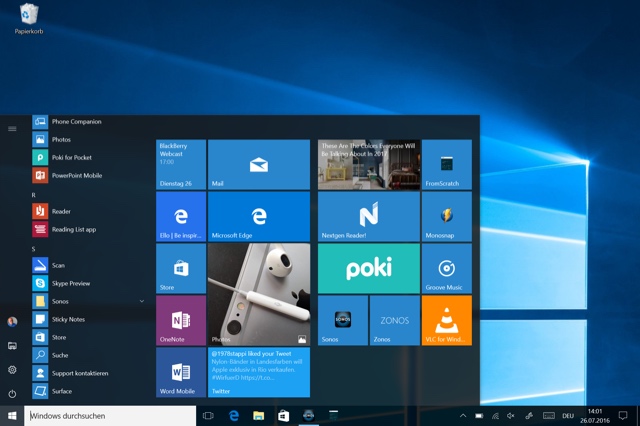
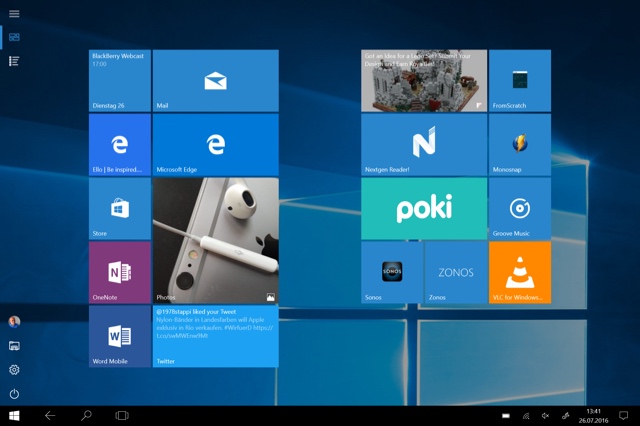
Next Tuesday the "Anniversary Update" of Windows 10 is upon us. What does that mean? Nothing.
Windows used to be distributed on physical media. There was a "Release to Manufacturing" date. And a ship date. But today, there is continuous delivery. Features get added, bugs get fixed. You can be on the Windows Insider program and get those changes earlier, you can even be lagging behind the current "release" as an Enterprise that has to be careful to avoid thousands of helpdesk calls.
Windows 10 isn't done. It will never be done. It's under construction, for the foreseeable future. For Windows phone it's not even in a state where it could be rolled out to all devices. On PCs it will be many different experiences, depending on the drivers you need for your hardware.
Windows is work in progress. And it has never been better than now.
Should you upgrade to Windows 10 now, while it is free? I believe you should. Despite all the Microsoft marketing efforts to destroy it.
Samsung Galaxy S8 Codenamed ‘Project Dream’; To Feature 4K Display
 The world is eagerly anticipating the launch of the Galaxy Note 7 next week from Samsung, but rumors about the company’s flagship for next year, the Galaxy S8, have started making their way to the internet. While we have heard a bit about Samsung’s flagship handset for next year, some new rumors coming out of China provide a clearer picture about it.
Continue reading →
The world is eagerly anticipating the launch of the Galaxy Note 7 next week from Samsung, but rumors about the company’s flagship for next year, the Galaxy S8, have started making their way to the internet. While we have heard a bit about Samsung’s flagship handset for next year, some new rumors coming out of China provide a clearer picture about it.
Continue reading →
Arbutus Greenway
Once the transaction between the City and CP was completed, work to remove the track and formation proceeded – and faster than expected. Since the Arbutus right of way was always one of my regular walking routes I have been documenting the process on Flickr. Looking at my latest effort there made me think that perhaps the blog reaches a different audience, and this might be a place to start a conversation about what the Greenway is going to look like. My impression is that there cannot be a standard end to end treatment, though some elements will need to be continuous. The integration of the Greenway into the neighbourhood is going to be critical to its success.
Between King Edward and 16th Avenues there is now a wide smooth pathway, awaiting blacktop. Very much more comfortable to use than the old railway and informal path. Nothing has yet been done with the crossings, nor the transverse pedestrian paths.
Grading south of King Edward Avenue W
The new greenway path is at least 7m wide in this section, with considerable amounts of land on each side.
Apparently someone wants the crossbucks preserved in place. I am not so sure that is a Good Idea: road signs should inform or warn of real present situations not outdated ones.
You can search Orders in Council but I couldn’t find one using that number.
Very little has been done to the right of way between 16th and Broadway. Inevitably parking is spreading like a plague across the available space behind the car maintenance businesses at the intersection of Arbutus and 12th Avenue.
Abandoned ties that are not much use for landscaping as they would have been treated with creosote: the contractors seem to have been remiss in not removing these
This section has Quilchena Park to the right and Maple Crescent to the left. I am baffled why this park isn’t green on Google Maps.
Informal access to Quilchena Park
The designers of the greenway will need to consider how to integrate it into the adjacent properties. A railway needs to have a barrier to limit trespass, but a bike a pedestrian way needs something else. Cyclists need to be deterred from using it as a racetrack, and pedestrians need to have reasons – and opportunities – to linger. There has to be more than the occasional bench, drinking fountain and securable bike parking – though all three are essentials. A Greenway is not a sewer to pull traffic through like a stroad, but a place in its own right. A destination as a much a passageway.
At this particular point, it looks like stairs may be required. Fortunately alternate flat access is not far away.
I think it’s daft that the railway crossing signs have been left in place
Even dafter is removing the City’s own signage before the work is even started, let alone completed!
This pathway and its connections to the local road network need better definition and surface(s).
The amount of land available along the route varies considerably, but most bas been left to vegetate, mostly shrubs, scrub and the invasive, prolific himalayan blackberry. These sites must not be neglected but deliberately adapted to improve both their community utility and landscape value.
As matters progress I imagine that I will return to this topic. So for now I have given it its own category
Filed under: Arbutus Greenway, Transportation
It never rains but it pours: Manchester derby cancelled, but more games expected as Chinese ambitions grow
It’s fitting that torrential rain in Beijing put paid to Manchester United against Manchester City at the National Stadium on Monday evening.
Set List for the Tragically Hip at Rogers Arena in Vancouver
Last night I saw the Tragically Hip in concert, presumably for the last time. I didn’t enjoy the show nearly as much as the previous two times I’d seen them–when they played in Toronto and Vancouver on the same day in 1992 and at the Ambassador Theatre in Dublin in 2002. But I was grateful to watch what felt like a historic show in a historic tour.
I took note of the playlist, which was organized into blocks of songs from different albums. I also made a Spotify playlist of the set list:
Twist My Arm
Three Pistols
The Luxury
Little Bones
Machine
Tired as Fuck
What Blue
In a World Possessed by the Human Mind
(Break for the band)
At Transformation
Man Machine Poem
The Lookahead
We Want to Be It
Membership
Fireworks
Bobcaygeon
Poets
(Short break for Downie)
Daredevil
So Hard Done By
Thugs
Grace, Too
Encore
Fully, Completely
Wheat Kings
Locked in the Trunk of the Car
Second Encore
Opiated
New Orleans is Sinking
"What all forms of fascism have in common is the glorification of the nation, and the exaggeration of..."
-
Adam Gopnik, Being Honest About Trump
Apple users drive 97 percent of mobile revenue, says report
According to a report from Demac Media, which builds ecommerce solutions for its merchant customers, Apple users drive a majority of mobile revenue (97 percent) and encouraging return customers is more key to growth than attracting new ones.
The Ecommerce Benchmark Report for Q2 2016 looked at data from 45 retailers that are customers of Demac Media, and examined data that included conversion by device and channel and discovery.
“Good SEO hygiene continues to generate higher organic traffic. Search engines like Google have become an invaluable tool for shoppers doing research on their intended purchases, and should never be overlooked,” the report said. Organic search generated the most traffic with 39 percent of users finding retailers using this method; the second biggest source of traffic was direct, at 17 percent.
When it came to traffic driven by social networks, Facebook, Pinterest, and Instagram collectively drive 93 percent of social network traffic; while Facebook took the biggest piece of the pie with 68 percent of traffic, Pinterest and Instagram trailed at 13 and 12 percent respectively.
According to the report, conversion rates jumped to 97 percent between the first and second site visit. “It is rare that a shopper buys on their first visit to your site; most shoppers are still in discovery and research mode,” the report said. In all cases, though, a shopper’s visit last an average of under four minutes — making strong user experience key.
The report noted that mobile beat desktop in retail website traffic, and that these mobile “window shoppers” eventually lead to revenue.
This post was also published on Betakit.
Das Attentat von München und die Medien
|
mkalus
shared this story
from |
Zur Berichterstattung über das Attentat in München am vergangenen Freitag und all ihren Schwächen starteten noch am selben Abend viele Diskussionen. Sie drehten sich um grundsätzliche Fragen: Sollten Redaktionen besser erstmal abwarten, wie sich das Geschehen entwickelt, oder direkt live auf Sendung gehen? Tragen TV-Sender durch die Verbreitung von Gerüchten zu sehr zur Panik bei? Ist ein öffentlich-rechtlicher Newskanal nötig, der rund um die Uhr Nachrichten sendet und in Ausnahmesituationen schneller reagieren kann (übrigens eine Diskussion, die es schon länger gibt)?
In diesem Blogpost soll es um verschiedene Beobachtungen und ganz konkrete Beispiele gehen, in denen sich Medien unserer Meinung nach problematisch verhalten haben oder gar falsch berichtet wurde.
***
Am vergangenen Freitag um 18:24 Uhr, also noch elf Minuten, bevor die Polizei München bei Twitter zum ersten Mal vor der Situation am Olympia-Einkaufszentrum warnte und darum bat, den Bereich ums OEZ zu meiden, twitterte „BR24“, das Online- und App-Team des „Bayerischen Rundfunks“:

(Den Tweet hat die Redaktion recht schnell wieder gelöscht.)
Wie hätten die nächsten Anfragen ausgehen, wenn sich jemand bei „B24“ gemeldet hätte? Vielleicht: „Könntest Du mal im Einkaufszentrum nachschauen, wie es da so aussieht und für uns mit dem Handy draufhalten?“?
***
Als dann die ersten Kamera-Teams und Live-Reporter am Einkaufszentrum angekommen waren, standen sie teilweise gefährlich nah am Tatort und/oder den Truppen der Polizei im Weg:
"Die beiden Polizisten, die mir gerade einen Platzverweis erteilt haben …" @bild-Reporter gerade im Livestream … @BILDblog #München
— Martin Dowideit (@MDowideit) 22. Juli 2016
Bei RTL konnte man sogar live mitverfolgen, wie Fotografen von den Beamten weggeschickt werden mussten:
Live-Bilder auf RTL von einem Zugriff der Polizei. Waren dann Pressefotografen, die verbotenerweise in abgesperrtem Bereich unterwegs waren
— Dorin Popa (@NiceBastard) 22. Juli 2016
***
Positiv aufgefallen ist uns am Freitagabend, dass viele Medien ohne das Zeigen von verletzten oder getöteten Menschen auskamen. Möglicherweise lag die Zurückhaltung schlicht daran, dass den Redaktionen nicht viele Fotos oder Videoaufnahmen von Opfern zur Verfügung standen. Aber es gab sie. Und Bild.de wollte nicht auf das Zeigen von Blutlachen und Toten verzichten:

(Zusätzliche Unkenntlichmachungen durch uns.)
Die Redaktion fand das Foto so zeigenswert, dass sie es in den folgenden Stunden und Tagen gleich mehrfach verwendete:




Und auch „Bild“ druckte den Mann ab, der durch einen Kopfschuss getötet wurde:

Immerhin: Bild.de und „Bild“ haben mindestens das Gesicht, teilweise auch den kompletten Oberkörper des Mannes verpixelt. Und dennoch ist das Zeigen dieses Fotos, ob verpixelt oder nicht, problematisch — allein schon wegen der Uhrzeit der Veröffentlichung.
Erstmals ist uns das Foto um 20:42 Uhr bei Bild.de begegnet, ganz oben auf der Seite. Gut möglich, dass es da schon einige Minuten online war. Es handelt sich also um einen Zeitpunkt, zu dem die Identifizierung des Opfers aller Wahrscheinlichkeit nach noch nicht abgeschlossen war, und somit auch die Angehörigen noch nicht informiert gewesen sein dürften. Sollten diese (wohl wissend, dass ihr Vater/Sohn/Ehemann rund ums Olympia-Einkaufszentrum unterwegs war) auf der Suche nach Informationen zum Attentat auch bei Bild.de vorbeigeschaut haben, könnten sie beim Aufrufen der Website zumindest stark verunsichert worden sein. Denn das auffällige rote Oberteil des Mannes dürften sie wiedererkannt haben.
Dass dieses Szenario nicht gänzlich unwahrscheinlich ist, zeigt diese Passage aus einem „Focus Online“-Text zum Attentat in München:
Zu Hause wartete schon ihre kleine Schwester. „Sie lag weinend auf dem Sofa.“ Jetzt wird Cahuans H. klar: Nicht alle Bekannten sind in Sicherheit. Sie erfährt: Der Bruder einer Freundin wurde erschossen. Auf einigen Fotos von Augenzeugen sieht man den Jungen, er trägt einen roten Pullover. Cahuans H. berichtet von Handyanrufen, in denen die Schwester des Erschossenen ins Telefon schreit. „Er ist tot, ich habe sein Handy, er ist tot!“
Und auch der Vater des Täters hat seinen Sohn kurz nach den ersten Schüssen anhand eines wackeligen Handyvideos, das im Internet kursierte, erkannt und sich bei der Polizei gemeldet.
Völlig allein waren „Bild“ und Bild.de übrigens nicht — bei „N24“ sollen ebenfalls Opfer zu sehen gewesen sein:
Und N24 zeigt Opfer. Unfassbar! #münchen //cc @DJVde @BILDblog
— Sebastian Pertsch (@Pertsch) 22. Juli 2016
***
Neben all diesen hässlichen Vorgängen gab es am Freitagabend und in den vergangenen Tagen auch großes Lob: für das Social-Media-Team der Polizei München. Die Beamten twitterten in der Nacht von Freitag auf Samstag sachlich, aber sehr bestimmt, sie warnten in verschiedenen Sprachen, baten um Mithilfe bei der Aufklärung der Tat und um Zurückhaltung beim Streuen von Gerüchten.
Julian Röpcke, „Political editor“ von „Bild“ und Bild.de, gefiel das, was die Polizei München bei Twitter veranstaltete, hingegen gar nicht:
.@PolizeiMuenchen twittert "Gerüchte" und "unconfirmed reports".
*sprachlos* … pic.twitter.com/49fhEIFO5O— Julian Röpcke (@JulianRoepcke) 22. Juli 2016
Röpckes Kritik bezog sich auf diesen Tweet der Polizei:
Gerüchte um eine #Schießerei in der City bekannt. Die Lage ist noch unklar! Bitte meidet öffentliche Plätze sowie U/SBahn #oez #München
— Polizei München (@PolizeiMuenchen) 22. Juli 2016
Wenn also eine offizielle Stelle in einer unübersichtlichen Situation darum bittet, vorsichtig zu sein, auch wenn noch nicht ganz klar ist, ob „in der City“ Gefahr besteht, macht das Julian Röpcke „*sprachlos*“.
Sein „Bild“-Kollege Björn Stritzel, mit dem Röpcke am Freitagabend zusammen an einem Text zum Attentat arbeitete, verbreitete hingegen wirklich gefährliche Gerüchte:
There are some indications that the shooter(s) could be rightwing extremists.
— Björn Stritzel (@bjoernstritzel) 22. Juli 2016
Gerade einmal 70 Minuten später wurde aus dem möglichen „rightwing extremist“ ein möglicher Islamist:
Shooter reportedly shouted Allahu Akbar. https://t.co/BwgI5mwBP4
— Björn Stritzel (@bjoernstritzel) 22. Juli 2016
***
Das Gerücht, dass es sich bei dem Attentat um einen islamistischen Terroranschlag handeln könnte, schaffte es auch auf die Website der „Hessischen Niedersächsischen Allgemeinen“. In einem Kommentar schrieb „HNA“-Redakteur Jörg-Stephan Carl um 21:17 Uhr — als also noch nicht wahnsinnig viel über die Tat und ihre Hintergründe bekannt war:

Die Islamisten haben der ganzen Welt den Krieg erklärt. Der Fanatismus, der religiös angestachelte Allmachtswahn, die Mordlust der Dschihadisten machen vor niemandem halt. Deutschland hatte bisher weitgehend Glück, der große Anschlag war ausgeblieben. Das Glück ist aufgebraucht.
Es deutet alles darauf hin: Der islamistische Terror ist in Deutschlands Großstädten angekommen. […]
Sich gegen Terror wehren, bedeutet immer auch, ihn aushalten zu müssen. Bei allem Entsetzen, bei aller Wut auf die Täter, bei aller Trauer über die Opfer — es klingt schal nach den Ereignissen in München: Aber das normale — das freie — Leben muss weitergehen, der Islamismus darf nicht triumphieren.
Am Samstag, als klar war, dass die Tat keinen islamistischen Hintergrund hatte, veröffentlichte die „HNA“ den Kommentar um 8:42 Uhr noch einmal. Die Redaktion hatte den Text umgestellt und Textteile zum Islamismus gestrichen. Unter anderem findet man im Kommentar nun diese Passage:
Nach all dem durchlittenen Terror in den Metropolen Europas beschleicht einen sofort die bange Angst: Ist der islamistische Terror auch in einer deutschen Großstadt angekommen? Am Freitagabend wusste das noch niemand. Inzwischen geht die Polizei von einem jugendlichen Einzeltäter aus.
***
Am Samstag und Sonntag wurde die Berichterstattung, mit mehr Zeit für die Recherche, nicht zwingend besser. Die Redaktionen von Bild.de und „Bild am Sonntag“ haben sie zum Beispiel dafür genutzt, sich Fotos der Opfer zu besorgen:

Diese und alle weiteren Unkenntlichmachungen durch uns.)

(„Bild am Sonntag“ hat die Fotos auf der Titelseite und noch ein weiteres Mal im Innern der Zeitung komplett ohne Verpixelung veröffentlicht, Bild.de mit einem sehr schmalen Balken über den Augen; inzwischen hat Bild.de die Gesichter einiger Opfer stärker verpixelt, andere zeigt die Seite wiederum ohne jegliche Verpixelung.)
Als Quelle gibt Bild.de bei den meisten Fotos „privat“ an. Was in der Regel so viel heißt wie: in den Sozialen Medien zusammengeklaubt. Persönlichkeitsrechte und der Respekt vor der Trauer der Angehörigen spielen bei der Jagd nach Fotos offenbar keine Rolle.
***
Bei „Focus Online“ hat die Redaktion die Zeit ebenfalls genutzt und ziemlich genau recherchiert, wo die Familie des Attentäters wohnt. In einem Artikel beschreibt das Portal seinen Lesern die Lage der Wohnung in München sehr detailliert — den Straßennamen, ein Foto des Hauses, das Stockwerk, in dem sich die Wohnung befinden soll, dazu Informationen aus dem Leben der Eltern, den Beruf des Vaters. Wer die Familie irgendwann mal aufsuchen will, muss sich nur den „Focus Online“-Text schnappen (auf einen Link oder einen Screenshot der Überschrift verzichten wir bewusst).
***
Natürlich sammelten und veröffentlichten viele Medien auch jegliche Details, die sie zum Täter finden konnten. Der Psychologe Jens Hoffmann warnt schon seit Jahren und auch aktuell im Interview mit den „Dresdner Neuesten Nachrichten“ genau davor:
Wie wären Trittbrettfahrer jetzt zu vermeiden?
Hoffmann: Durch sehr vorsichtige Berichterstattung. Wir raten in solchen Fällen immer: Zeigt nicht das Gesicht des Täters, nennt nicht den Namen. Er soll nicht zur „Berühmtheit“ werden, sondern dem Vergessen anheimfallen. Das kann Nachahmer abschrecken. Ich fand es eine sehr gute Entscheidung, das Gesicht des Täters in dem Video zu verpixeln, das ihn beim Schießen zeigt.
Dennoch zeigen viele Onlineportale, viele Zeitungen, viele TV-Sender Fotos des Attentäters. Ein Großteil kürzt seinen Namen ab, aber nicht alle. Die massive Berichterstattung über seine Person macht ihn jedenfalls zum Star. Er bekommt für seiner Tat Aufmerksamkeit und Reichweite.
Besondere hilfreich sind dabei die „Bild“-Medien:





Bild.de veröffentlicht sogar Artikel, die sich wie Manuskripte von Actionfilmen lesen:

Er rennt durch die Nacht. In Panik. Überall Polizei. Es ist erst wenige Stunden her, da erschoss A[.] kaltblütig neun Menschen. In einer Seitenstraße bleibt er stehen. Und richtet die Waffe auf seinen Kopf…
Der Text geht in diesem Ton weiter. Viel stärker kann man eine schreckliche Tat nicht auf ein Podest heben.
Aber auch andere Blätter machen mit und packen das Foto des Täters auf ihre Titelseiten (immerhin beide mit einem schmalen Balken über den Augen):


Dass es auch anders geht, selbst im Boulevard, hat am Sonntag die „B.Z.“ gezeigt:

Mit großem Dank an alle Hinweisgeber!
Vancouver and Victoria transit options now visible in Apple Maps
Over a year after Apple announced it was building a transit feature into Maps with iOS 9, that feature is now rolling out in Vancouver and Victoria, along with SkyTrain and West Coast Express lines that operate in other areas of British Columbia. The update means that users can now route plan using a combination of trains, subways, buses and walking.
The new feature also allows users to see SkyTrain and bus routes, schedules and transit entrances and exits clearly overlaid on the map of the city. Entrances and exits, aside from just indicating locations, also informs users about accessibility options.
The only other Canadian locations where the transit feature currently functions are Toronto and Montreal.
Related reading: Apple adds transit directions to Maps in iOS 9, Toronto is currently the only Canadian location
Susan Chen, Promoted to Vice President of Business Development
I’m excited to announce that Susan Chen has been appointed Vice President of Business Development at Mozilla, a new role we are creating to recognize her achievements.
 Susan joined Mozilla in 2011 as Head of Strategic Development. During her five years at Mozilla, Susan has worked with the Mozilla team to conceive and execute multiple complex negotiations and concluded hundreds of millions dollar revenue and partnership deals for Mozilla products and services.
Susan joined Mozilla in 2011 as Head of Strategic Development. During her five years at Mozilla, Susan has worked with the Mozilla team to conceive and execute multiple complex negotiations and concluded hundreds of millions dollar revenue and partnership deals for Mozilla products and services.
As Vice President of Business Development, Susan is now responsible for planning and executing major business deals and partnerships for Mozilla across its product lines including search, commerce, content, communications, mobile and connected devices. She is also in charge of managing the business development team working across the globe.
We are pleased to recognize Susan’s achievements and expanded scope with the title of Vice President. Please join me in welcoming Susan to the leadership team at Mozilla!
Background:
"If you’ve ever pixelated an email address or blurred a phone number before putting an image onto the..."
-
Pixelating and blurring doesn’t work to hide text | Fusion (via infoneer-pulse)
That’s wonderful!
Are Empty High-End Restaurants The Next Coworking Trend?
I saw a movie years ago where a San Francisco PI used a table at a Chinese restaurant as his office. ‘How cool is that?’ I wondered.
But startups like Spacious and CoworkCafe are making that a reality:
CoworkCafe offers a more relaxed vibe that many members (who include a novelist, software developers, marketing consultants, and nonprofit professionals) like. “Having a place that’s relaxed and comfortable is very good for creative type work,” he says. “There’s a certain feeling that you get in a place like this you can’t get in an office-type building. They really love the feeling of the space; they don’t want to be in a traditional office setting.”
“I have a choice of staying for happy hour. It doesn’t feel like I’ve left a long workday.”
New York-based content strategist Angela Pham echoes those sentiments about Spacious, a startup that turns high-end restaurants into coworking spaces during the day. “There’s a mental and psychological perk [to the setup],” she says. “There’s a different mood when you leave your home office versus a restaurant. I can either leave when I’m done with my work or I have a choice of staying for happy hour. It doesn’t feel like I’ve left a long workday.” She’s tried working from home or from Starbucks and found neither environment conducive to her work.
Spacious started operating in December and has expanded to several New York City restaurants, with plans to create new partnerships in San Francisco, Los Angeles, and London in the future, according to cofounder and CEO Preston Pesek. Spacious’ ideal restaurant partners are those who’ve “spent a lot of time thinking about the ambiance; we look for really good interior design,” he says. Proximity to public transportation is another key consideration. Spacious’ current restaurant partners include DBGB Kitchen & Bar and L’Apicio.
The restaurants can offer the high-end coworking frills, like a storage area or large monitors, so I can’t have a deskphone come out of a drawer in the table, like the PI did in my noir movie.
But the price – Spacious charges members $95/month or $30 for a day pass – can’t be beat. And I love the sausages at DBGB.
"While the habits of hatred get the better of the right, the habits of self-approval through the..."
-
Adam Gopnik, Being Honest About Trump
Platform wars: the final score
The smartphone platform wars are pretty much over, and Apple and Google won. But it's interesting, in passing, to note the final score, and think about what it means.
Globally, something around 5bn people (give or take perhaps 250m each way) have a mobile phone, out of around 5.5bn people over the age of 16. (This number is fuzzy because many people have more than one SIM card). This will rise to closer to 6bn over the next few years as the population and the penetration grow.
Apple said in January 2016 that it has "1 billion" active devices (a nicely rounded number), across the Mac, iPhone, iPad, iPod, Apple TV and watch. Of these there are around 90m Macs (Tim Cook said 80m in early 2014), something over 10m watches, closer to 20m Apple TVs and perhaps as many iPods still in use. That leaves something close to 900m iPhones and iPads. Apple has sold 318m iPads - if we assume a 3 year lifespan for iPhones and 4 years for iPads that gets an install base in December 2015 of 630m iPhones and 250m iPads, or 880m in total - close enough. Given both iPad and iPhone sales have been flat since then, this number probably hasn't changed much.
China Mobile said that in Q1 2016 15% of its 830m active base were using iPhones - so 125m of those 630m iPhones. China Mobile has 60% of Chinese mobile subscriptions (note as above, this is not the same as users per se), but as the premium operator it has 73% of 4G, which is probably more relevant. This implies something around 175m iPhones in China across all three operators. This is more iPhones than there are in the USA. (Note that not all of these were sold in China - this includes imported second-hand devices as well.)
Overall, the Chinese mobile operators reported 591m 4G subscribers in Q2 2016, and 808m combined 3G & 4G users at the end of 2015, when the Chinese government reported 620m mobile internet users (rising at a bit over 2% a quarter). One should be very cautious combining numbers from different sources with different methodology, but this implies that if there were 175m iPhones in Q1, that leaves perhaps 450m or so to be Android (or at least Android that go online). Of course, this is Chinese Android - not a fork, but lacking any Google services and excluded from Google's statistics. Meanwhile, the government also reports 220m people using tablets to go online (see footnote). It's not clear how many of these are shared, so one should round this down a bit.
Then we have Google Android (as opposed to Chinese Android). Google has always been constructively opaque about Android statistics, using shifting metrics that never quite reconciled with each other. The last time it gave a solid number for the active base was September 2015, when it said there were 1.4bn active Google Android users. According to the Android developer dashboard at that time, about 10% of the active base had a large or extra-large screen, implying a tablet - so, 1.25bn phones and 150m tablets, rounded. How much has this risen since? Well, on most estimates smartphone sales overall have been pretty flat for the last few quarters, with any marginal sales coming at the very low end (the entry price for Android is now well under $50). So this base might have risen by (say?) 100m, but probably no more. Plotting this as a chart (showing only Google's rounded numbers at scheduled events), a March 2016 number of 1.5bn total Google Android and hence 1.35bn phones looks plausible, and might be high.

So, for March 2016:
- 630m iPhones and 250m iPads, for a total of 880m
- 1.3-1.4bn Google Android phones, and 150-200m Google Android tablets.
- Maybe 450m additional Android phones and 200m Android tablets in China, not connected to Google services
- For a total base of 2.4-2.5bn iOS and Android phones, and (say) 600m-750m iOS and Android tablets.
Some of these numbers are quite a long way from what people not digging deep into the data might expect. I posted this not-entirely-scientific poll on Twitter last week and got the following wildly wrong results. The correct answer is under 2.5x, but 2/3 of people voted for over 4x, which would require 2.5-3bn Google Android phones.
Perceptions: how many more Google Android smartphones than iPhones are in use globally today?
— Benedict Evans (@BenedictEvans) July 17, 2016
These numbers illustrate the fundamental change in scale that the shift to mobile represents for the tech industry. Annual smartphone sales will rise to close to 2bn units and PC sales fall to close to 200m, while the smartphone install base will rise from 2.5bn to close to 5bn and the PC install base fall from today's 1.5bn to closer to 1bn (if that). So mobile has 10x the unit volume and 5x the install base - 'a billion is the new million'. This is why all the industry investment is shifting to the ARM/iOS/Android ecosystem from the WinTel ecosystem.
Meanwhile, it's now perfectly clear that both Apple and Android have sufficient scale for their ecosystems to be viable (including the Android subset in China), and that no-one else does. But at the same time, once you've achieved that scale, further changes in market share are not very meaningful. It doesn't matter to a product manager at a big US bank how many Android users there are in China, nor to a product manager launching in India how any iPhones are in California. Where your users are, which users you want and which users spend what is more important.
That is, the war is over. Yes, we'll go from 2.5bn smartphones to 5bn, but the dynamics of the two ecosystems will not change much with that growth. Apple will get some more uses, perhaps, while Android will convert most of that next 2.5bn, but most of those people are in emerging markets and most will be buying phones for under $50 and certainly under $100.
Rather, the changes, and the things to think about, come from other directions - VR and AR on one hand, AI and machine learning on the other. They might change the balance between Apple and Google, but they're more likely to make that distinction boring. I stopped updating my Nokia, RIM and Microsoft models a while ago - my Android and Apple models are increasingly lower on my priority list too.
Note 1: if you're thinking all of this methodology is vague and somewhat fuzzy, you're right, but that's how the sausage is made. I wrote a long piece about these issues here.
Note 2: Both the Google Android and Chinese Android tablet numbers I've mentioned are explicitly devices that are going online. There's a significant gap between the numbers of Android that are seen online and the numbers that are reported as sold to consumers. The core of this is that there are really two tablet markets: the 'PC replacement' vision of Apple and high-end Android tablets, and another almost separate market for generic cheap black plastic tablets that don't last long and/or never or rarely go online - this might increase the base by at least a third, maybe more.
Photolab App Review
The much-anticipated London Drugs Photolab app is available at last! Available for free on the iPhone and iPad (the Android phone/tablet version of the app is still in the works), it lets you upload photos or log in and select from your existing LD Photolab albums, choose the dimensions and finish of your print, and even order fine art prints like bamboo, canvas or metallic. Just like the new website, the app is stable, intuitive, and incredibly simple to use. Since most people these days keep most of their photos stored on their smartphone, developing an app was a pretty logical step. The main purpose of the app at this point, however, is to allow you to conveniently order prints and enlargements from anywhere, while the Photolab website and in-store kiosks allow you to create a wider variety of print products; gallery wraps, prints on aluminum, and non-traditional products like photo mugs, cards, photo books and calendars.
Anyway, rather than have this post be a lengthy, step-by-step written walkthrough with screenshots, I’ve decided to include the first ever video demonstration on the Photoblog. Ok, well… it’s the first video demo for a product created 100% by and for the Photolab. On top of that, it’s the first video demo I’ve ever done for anything. Yes, I freely admit that as far as voiceovers go, Sir Richard Attenborough’s legacy is still quite safe; but hey, the app is the star of the video, not me, and this is the best way to showcase its many convenient features. Well, actually the best way is to download the app to your iPhone or iPad and try it out for yourself. Who knows? It may even inspire you to create your own Photolab app demo video.
Video correction: To clarify, the Photolab app can only access the photo albums located in the iOS Photos app, including those created by (or imported from) other apps like Instagram, Moldiv, VSCO or Snapseed. Apologies for the confusion.
Video correction #2: In the voiceover I also appear to mention that you can order metal prints; indeed, I should have said “metallic prints”. It’s the kind of spoken word error that Sir Richard Attenborough would have never made.
Twitter Favorites: [SnarkySteff] Yesterday I wrote about being depressed while travelling, including tips for battling it. https://t.co/barRwv1Q4l #ttot
Yesterday I wrote about being depressed while travelling, including tips for battling it. fullnomad.com/2016/07/23/dep… #ttot
Twitter Favorites: [bmann] @Stv @toddsmithdesign @counti8 also: culture as defined by Ingress players, which has skewed demographics (& don’t live in suburbs)
@Stv @toddsmithdesign @counti8 also: culture as defined by Ingress players, which has skewed demographics (& don’t live in suburbs)
Twitter Favorites: [BookRiot] Why it's okay to quit the book you're not enjoying: https://t.co/hTZ61GKYb1 https://t.co/ayVUWlvx1P
Why it's okay to quit the book you're not enjoying: bit.ly/2alGkoO pic.twitter.com/ayVUWlvx1P
Acorn 5.5b2 Is Ready for Testing
I've been working on the next update to Acorn, version 5.5, and I've got a build ready for folks to try out. I'm calling it beta 2. Hello, it's nice to meat you.
Color improvements are the focus Acorn 5.5. The biggest change is a new color loupe tool for Acorn which will allow you to seamlessly select colors from the canvas as well as anywhere on your display (and correctly match your display's color to the selected color profile of your image).
This is super important as displays with a wider-than-sRGB-gammut (such as the recent iMacs) are starting to show up on our desktops. For instance, if you have an iMac with the Display P3 profile set and you're working on an sRGB image, selecting a color from anywhere on your display will correctly match it to your image. Colors are hard, but Acorn is making it so you don't even have to think about it.
You can bring up the color loupe tool by pressing the option key when using Acorn's various drawing tools, or by pressing Control-C when you have an image open.
And besides supporting wide color gamuts, Acorn 5 has always supported deep images (16 bits per component), which is going to be increasingly important this fall when Sierra ships with deep color support in AppKit, and if you're paying attention to the tea leaves for iOS…
New dither filters, shape processor improvements, and various Quality of Life things are in Acorn 5.5b2 as well.
The full (and constantly updating) beta release notes for Acorn are available as well. Grab Acorn 5.5b2 here.
Stunning video of Vancouver. Proud to call this place home (with...
Stunning video of Vancouver. Proud to call this place home (with all its beauty and imperfections) .
iPhone 7 rumoured to be released week of September 12
September is usually when Apple unveils its latest iPhone and it seems this year will be no different.
The next smartphone from Apple is tipped to be called the iPhone 7, which follows the iPhone 6s. Reputable device leaker Evan Blass stated on Twitter the company will go live with sales the week of September 12th. Blass later clarified his Tweet by noting, “To be even more specific, it should happen on Friday, Sept. 16th.”
Last year, the iPhone 6s and iPhone 6s were announced on September 9th with general availability on September 24th.
Just to clarify, this refers to the retail release, not the launch event. To be even more specific, it should happen on Friday, Sept. 16th.
— Evan Blass (@evleaks) July 23, 2016
Rumours have the iPhone 7 coming with the same design as its predecessors but expected to sport a more pronounced camera bump, larger flash, 3GB of RAM, slimmer bezels, and lacks the audio jack in favour of a Lightning-to-3.5mm dongle.
Firefox 49.0 Aurora Testday Results
Hello mozillians!
Last week on Friday (July 22nd), we held another successful event – Firefox 49.0 Aurora Testday.
Thank you all for helping us making Mozilla a better place – Moin Shaikh, Georgiu Ciprian, Marko Andrejić, Dineesh Mv, Iryna Thompson.
From Bangladesh: Rezaul Huque Nayeem, Nazir Ahmed Sabbir, Hossain Al Ikram, Azmina Akter Papeya, Md. Rahimul Islam, Forhad Hossain, Akash, Roman Syed, Niaz Bhuiyan Asif, Saddam Hossain, Sajedul Islam, Md.Majedul islam, Fahim, Abdullah Al Jaber Hridoy, Raihan Ali, Md.Ehsanul Hassan, Sauradeep Dutta, Mohammad Maruf Islam, Kazi Nuzhat Tasnem, Maruf Rahman, Fatin Shahazad, Tanvir Rahman, Rakib Rahman, Tazin Ahmed, Shanjida Tahura Himi, Anika Nawar and Md. Nazmus Shakib (Robin).
From India: Nilima, Paarttipaabhalaji, Ashly Rose Mathew M, Selva Makilan R, Prasanth P, Md Shahbaz Alam and Bhuvana Meenakshi.K
A big thank you goes out to all our active moderators too!
Results:
- there were 19 verified bug:
- No new issues found
- some failures were mentioned in the etherpad ; therefore, please add the requested details in the etherpad or, even better, join us on #qa IRC channel and let’s figure them out
I strongly advise everyone of you to reach out to us, the moderators, via#qa during the events when you encountered any kind of failures. Keep up the great work!
Keep an eye on QMO for upcoming events! 

